Human Wildlife Conflict and Impacts on Livelihood: A Study in Community Forestry System in Mid-Hills of Nepal
Abstract
:1. Introduction
2. Materials and Methods
2.1. Study Area
2.2. Data Collection
2.3. Land-Use and Land-Cover Change
2.4. Data Analysis
3. Results
3.1. Demographic Information
3.2. Trends in HWC
3.3. Livestock Predation
3.4. Crop Damage
3.5. Land-Use Types and HWC
3.6. Land-Use Change, Community Forest, and HWC
4. Discussion
5. Conclusions
Supplementary Materials
Author Contributions
Funding
Institutional Review Board Statement
Informed Consent Statement
Data Availability Statement
Acknowledgments
Conflicts of Interest
References
- Madden, F. Creating coexistence between humans and wildlife: Global perspectives on local efforts to address human-wildlife conflict. Hum. Dimens. Wildl. 2004, 9, 247–257. [Google Scholar] [CrossRef]
- Carter, N.H.; Shrestha, B.K.; Karki, J.B.; Pradhan, N.M.B.; Liu, J. Coexistence between wildlife and humans at fine spatial scales. Proc. Natl. Acad. Sci. USA 2012, 109, 15360–15365. [Google Scholar] [CrossRef] [PubMed] [Green Version]
- Aryal, K.P.; Poudel, S.; Chaudhary, R.P.; Chettri, N.; Chaudhary, P.; Ning, W.; Kotru, R. Diversity and use of wild and non- cultivated edible plants in the Western Himalaya. Ethnobiol. Ethnomed. 2018, 14, 10. [Google Scholar] [CrossRef] [PubMed]
- Rodger, A. Policy issues in wildlife conservation. Indian J. Public Adm. 1989, 35, 461–468. [Google Scholar] [CrossRef]
- Saberwal, V.K.; Dun, D.; Gibbs, J.P.; Haven, N.; Box, P.; Johnsingh, A.J.T. Lion-Human Conflict in the Gir Forest, India. Conserv. Biol. 1994, 8, 501–507. [Google Scholar] [CrossRef]
- Distefano, E. Human-Wildlife Conflict Worldwide: Collection of Case Studies, Analysis of Management Strategies and Good Practices; Food and Agricultural Organization of the United Nations (FAO), Sustainable Agriculture and Rural Development Initiative (SARDI): Rome, Italy, 2005; FAO Corporate Document Repository; Available online: http://www.fao.org/documents (accessed on 17 March 2021).
- Aryal, A.; Brunton, D.; Ji, W.; Barraclough, R.K.; Raubenheimer, D. Human—Carnivore conflict: Ecological and economical sustainability of predation on livestock by snow leopard and other carnivores in the Himalaya. Sustainability 2014, 9, 321–329. [Google Scholar] [CrossRef]
- Aryal, A. Factor people into tiger conservation. Nat. Corresp. 2015, 522, 287. [Google Scholar] [CrossRef] [Green Version]
- Lamichhane, B.R.; Persoon, G.A.; Leirs, H.; Poudel, S.; Subedi, N.; Pokheral, C.P.; Bhattarai, S.; Thapaliya, B.P.; De Iongh, H.H. Spatio-temporal patterns of attacks on human and economic losses from wildlife in Chitwan National Park, Nepal. PLoS ONE 2018, 13, e0195373. [Google Scholar] [CrossRef] [Green Version]
- CODEFUND. Profiling of Protected and Human Wildlife Conflict Associated Wild Animals in Nepal; DNPWC: Kathmandu, Nepal, 2017.
- Acharya, K.P.; Paudel, P.K.; Neupane, P.R.; Köhl, M. Human-wildlife conflicts in Nepal: Patterns of human fatalities and injuries caused by large mammals. PLoS ONE 2016, 11, e0161717. [Google Scholar] [CrossRef]
- Aryal, A.; Brunton, D.; Raubenheimer, D. Impact of climate change on human-wildlife-ecosystem interactions in the Trans-Himalaya region of Nepal. Theoret. Appl. Climatol. 2014, 115, 517–529. [Google Scholar] [CrossRef]
- Banikoi, H. Mitigating Human-Wildlife Conflict in Nepal: A Case Study of Fences around Chitwan National Park; ICIMOD: Kathmandu, Nepal, 2017. [Google Scholar]
- Gurung, B.; Smith, J.L.D.; McDougal, C.; Karki, J.B.; Barlow, A. Factors associated with human-killing tigers in Chitwan National Park, Nepal. Biol. Conserv. 2008, 141, 3069–3078. [Google Scholar] [CrossRef]
- Khan, M.; Khan, B.; Awan, S.; Begum, F. Livestock depredation by large predators and its implications for conservation and livelihoods in the Karakoram Mountains of Pakistan. Oryx 2017, 52, 519–525. [Google Scholar] [CrossRef]
- Taylor, P.; Crewe, T.; Mackenzie, S.; Lepage, D.; Aubry, Y.; Crysler, Z.; Finney, G.; Francis, C.; Guglielmo, C.; Hamilton, D.; et al. The Motus Wildlife Tracking System: A collaborative research network to enhance the understanding of wildlife movement. Avian Conserv. Ecol. 2017, 12, 8. [Google Scholar] [CrossRef]
- Aryal, A.; Lamsal, R.P.; Ji, W.; Raubenheimer, D. Are there sufficient prey and protected areas in Nepal to sustain an increasing tiger population? Ethol. Ecol. Evol. 2016, 28, 117–120. [Google Scholar] [CrossRef]
- DNPWC. Annual Progress Report (2017–2018); Department of National Parks and Wildlife Conservation: Kathmandiu, Nepal, 2018.
- Aryal, K.; Dhungana, R.; Silwal, T. Understanding policy arrangement for wildlife conservation in protected areas of Nepal. Hum. Dimens. Wildl. 2021, 26, 1–12. [Google Scholar] [CrossRef]
- Kunwar, R.; Bhattacharya, P. Community forestry and livelihood in Makawapur district, Nepal. In Joint Forest Management in India; Aavishkar Publishers: New Delhi, India, 2008; pp. 243–251. [Google Scholar]
- DOF. Hamro Ban; Department of Forests and Soil Conservation: Kathmandu, Nepal, 2019.
- Springer-Baginski, O.; Dev, O.; Yadav, N.; Soussan, J. Community Forest Management in the Middle Hills of Nepal: The Changing Context. J. For. Livelihood 2003, 3, 5–20. [Google Scholar]
- Bhattarai, B.; Wright, W.; Poudel, B.; Aryal, A.; Yadav, B.; Wagle, R. Shifting paradigms for Nepal’ s protected areas: History, challenges and relationships. J. Mt. Sci. 2017, 14, 964–979. [Google Scholar] [CrossRef]
- Acharya, K. Twenty-four years of community forestry in Nepal. Int. For. Rev. 2002, 4, 149–156. [Google Scholar] [CrossRef]
- Reddy, C.S.; Vazeed, P.S.; Satish, K.V.; Saranya, K.R.L.; Jha, C.S.; Krishna-Murthy, Y.V.N. Quantifying nationwide land cover and historical changes in forests of Nepal (1930–2014): Implications on forest fragmentation. Biodivers. Conserv. 2018, 27, 91–107. [Google Scholar] [CrossRef]
- Neupane, B.; Budhathoki, S.; Khatiwoda, B. Human-Elephant Conflict and Mitigation Measures in Jhapa District, Nepal. J. For. Livelihood 2018, 16, 103–112. [Google Scholar] [CrossRef] [Green Version]
- Adhikari, J.N.; Bhattarai, B.P.; Thapa, T.B. Human-Wild Mammal Conflict in a Human Dominated Midhill Landscape: A Case Study From Panchase Area in Chitwan Annapurna Landscape, Nepal. J. Inst. Sci. Technol. 2018, 23, 30–38. [Google Scholar] [CrossRef]
- Kunwar, R.M.; Fadiman, M.; Hindle, T.; Suwal, M.K.; Adhikari, Y.P.; Baral, K.; Bussmann, R.W. Composition of forests and vegetation in the Kailash Sacred Landscape, Nepal. J. For. Res. 2019, 31, 1625–1635. [Google Scholar] [CrossRef]
- Rimal, B.; Rijal, S.; Kunwar, R. Comparing Support Vector Machines and Maximum Likelihood Classifiers for Mapping of Urbanization. J. Indian Soc. Remote Sens. 2020, 48, 71–79. [Google Scholar] [CrossRef]
- Baral, S.; Adhikari, A.; Khanal, R.; Malla, Y.; Kunwar, R.; Basnyat, B.; Gauli, K.; Acharya, R.P. Invasion of alien plant species and their impact on different ecosystems of Panchase Area, Nepal. Banko Janakari 2017, 27, 31–42. [Google Scholar] [CrossRef]
- Katuwal, H.B.; Sharma, H.P.; Shaner, P.J.L.; Gurung, R.; Thapa, V.; Magar, T.G.; Gurung, T.B.; Parajuli, K.; Gurung, M.B.; Basnet, H.; et al. Updating spatial information of 27 mammal species in Nepal. J. Anim. Plant Sci. 2018, 28, 1735–1745. [Google Scholar]
- Sijapati, R.K.; Sharma, H.P.; Sharma, S.; Subedi, J.R.; Belant, J.L. Livestock Depredation by Leopards and Tigers Near Bardia National Park, Nepal. Animals 2021, 11, 1896. [Google Scholar] [CrossRef]
- Sapkota, S.; Aryal, A.; Baral, S.R.; Hayward, M.W.; Raubenheimer, D. Economic Analysis of Electric Fencing for Mitigating Human-wildlife Conflict in Nepal Economic Analysis of Electric Fencing for Mitigating Human-wildlife C onflict in Nepal. J. Resour. Ecol. 2014, 5, 237–243. [Google Scholar] [CrossRef]
- Redpath, S.M.; Young, J.; Evely, A.; Adams, W.M.; Sutherland, W.; Whitehouse, A.; Amar, A.; Lambert, R.A.; Linnell, J.D.C.; Watt, A.; et al. Understanding and managing conservation conflicts. Trends Ecol. Evol. 2013, 28, 100–109. [Google Scholar] [CrossRef] [PubMed]
- Bhuju, U.; Shakya, P.; Basnet, T.; Shrestha, S. Nepal Biodiversity Resource Book (Protected Areas, Ramsar Sites, and World Heritage Sites); ICIMOD: Kathmandu, Nepal, 2007. [Google Scholar]
- Adhikari, M.; Thapa, R.; Kunwar, R.M.; Devkota, H.P.; Poudel, P. Ethnomedicinal Uses of Plant Resources in the Machhapuchchhre Rural Municipality of Kaski District, Nepal. Medicines 2019, 6, 69. [Google Scholar] [CrossRef] [Green Version]
- MoFSC. State of Nepals Forest; Department of Forests and Soil Conservation: Kathmandu, Nepal, 2015; ISBN 978-9937-8896-3-6.
- CBS. National Population and Household Census 2011. National Report Submitted to Government of Nepal. National Planning Commission Secretariat. Central Bureau of Statistics, 2011. Available online: http://unstatsun.org/unsd/demographic-social/census/document/Nepal/Nepal-Census-2011-Vol1.pdf (accessed on 23 February 2021).
- Anderson, J.R.; Hardy, E.E.; Roach, J.T.; Witmer, R.E. A Land Use and Land Cover Classification System for Use with Remote Sensor Data; U.S. Geological Survey, 604 South Pickett Street: Alexandria, VA, USA, 1976. Available online: https://pubs.usgs.gov/pp/0964/report.pdf (accessed on 26 October 2019).
- R Development Core Team. R. A Language and Environment for Statistical Computing; R Foundation for Statistical Computing: Viena, Austria, 2019. [Google Scholar]
- Mishra, C. Livestock depredation by large carnivores in the Indian trans-Himalaya: Conflict perceptions and conservation prospects. Environ. Conserv. 1997, 11, 246–251. [Google Scholar] [CrossRef] [Green Version]
- Pandey, P.; Shaner, P.J.L.; Sharma, H.P. The wild boar as a driver of human-wildlife conflict in the protected park lands of Nepal. Eur. J. Wildl. Res. 2016, 62, 103–108. [Google Scholar] [CrossRef]
- Regmi, G.R.; Nekaris, K.A.; Kandel, K.; Nijman, V. Crop-raiding macaques: Predictions, patterns and perceptions from Langtang National Park, Nepal. Endanger. Species Res. 2013, 24, 238–243. [Google Scholar] [CrossRef] [Green Version]
- Mishra, H. Human Needs Balancing in Nepal’s Royal Chitwan. Ambio 1982, 11, 246–251. [Google Scholar]
- Amador-Alcalá, S.; Naranjo, E.J.; Jiménez-Ferrer, G. Wildlife predation on livestock and poultry: Implications for predator. conservation in the rainforest of south-east Mexico. Oryx 2013, 47, 243–250. [Google Scholar] [CrossRef] [Green Version]
- Karanth, K.K.; Naughton-Treves, L.; DeFries, R.; Gopalaswamy, A.M. Living with wildlife and mitigating conflicts around three. Indian protected areas. Environ. Manag. 2013, 52, 1320–1332. [Google Scholar] [CrossRef] [PubMed]
- Adhikari, B.; Odden, M.; Adhikari, B.; Panthi, S.; Lopez-Bao, J.V.; Low, M. Livestock husbandary paractice and herd composition influnce leopard- human conflict in Pokhara valley, Nepal. Hum. Dimens. Wildl. 2020, 25, 62–69. [Google Scholar] [CrossRef]
- Naughton-Treves, L.; Treves, A.; Chapman, C.; Wrangham, R. Temporal patterns of crop-raiding by primates: Linking food availability in croplands and adjacent forest. J. Appl. Ecol. 1998, 35, 596–606. [Google Scholar] [CrossRef]
- Manral, U.; Sengupta, S.; Hussain, S.A.; Rana, S.; Badola, R. Human wildlife conflict in India: A review of economic implication of loss and preventive measures. Indian For. 2016, 142, 928–940. [Google Scholar]
- Mwakatobe, A.; Nyahongo, J.W.; Ntalwila, J. The impact of crop raiding by wild animals in communities surrounding the Serengeti National Park, Tanzania. Int. J. Biodiv. Conserv. 2014, 6, 637–646. [Google Scholar] [CrossRef] [Green Version]
- Dahal, B.M.; Nyborg, I.; Sitaula, B.K.; Bajracharya, R.M. Agricultural intensification: Food insecurity to income security in a mid-hill watershed of Nepal Agricultural intensification: Food insecurity to income security in a mid-hill watershed of Nepal. Int. J. Agric. Sustain. 2015, 7, 249–260. [Google Scholar] [CrossRef]
- Gautam, A.; Shivakoti, G.; Webb, E. A review of forest policies, institutions, and changes in the resource condition in Nepal. Int. For. Rev. 2004, 6, 136–148. [Google Scholar] [CrossRef]
- Kanel, K.R.; Ram, B. Community Forestry in Nepal: Achievements and Challenges. J. For. Livelihood 2004, 4, 55–63. [Google Scholar]
- Paudel, K.P.; Tamang, S.; Shrestha, K.K. Transforming land and livelihood: Analysis of agricultural land abandonment in the Mid Hills of Nepal. J. For. Livelihood 2014, 12, 11–19. [Google Scholar]
- Jaquet, S.; Kohler, T.; Schwilch, G. Labour migration in the middle hills of Nepal: Consequences on land management strategies. Sustainability 2019, 11, 1349. [Google Scholar] [CrossRef] [Green Version]
- Khanal, U.; Alam, K.; Khanal, R.C.; Regmi, P.P. Implications of out-migration in rural agriculture: A case study of Manapang village, Tanahun, Nepal. J. Develop. Areas 2015, 49, 331–352. [Google Scholar] [CrossRef]
- DCC (Ed.) District Periodic Plan—Kaski; District Development Committee: Pokhara, India, 2019.
- DCC. District Profile—Tanahun; District Coordination Committee: Tanahun, India, 2019.
- Acharya, K.P.; Paudel, P.K.; Jnawali, S.R.; Neupane, P.R.; Köhl, M. Can forest fragmentation and configuration work as indicators of human–wildlife conflict? Evidences from human death and injury by wildlife attacks in Nepal. Ecol. Indic. 2017, 80, 74–83. [Google Scholar] [CrossRef]
- MoFE. Annual Progress Report; Department of Forests and Soil Conservation: Kathmand, India, 2018.
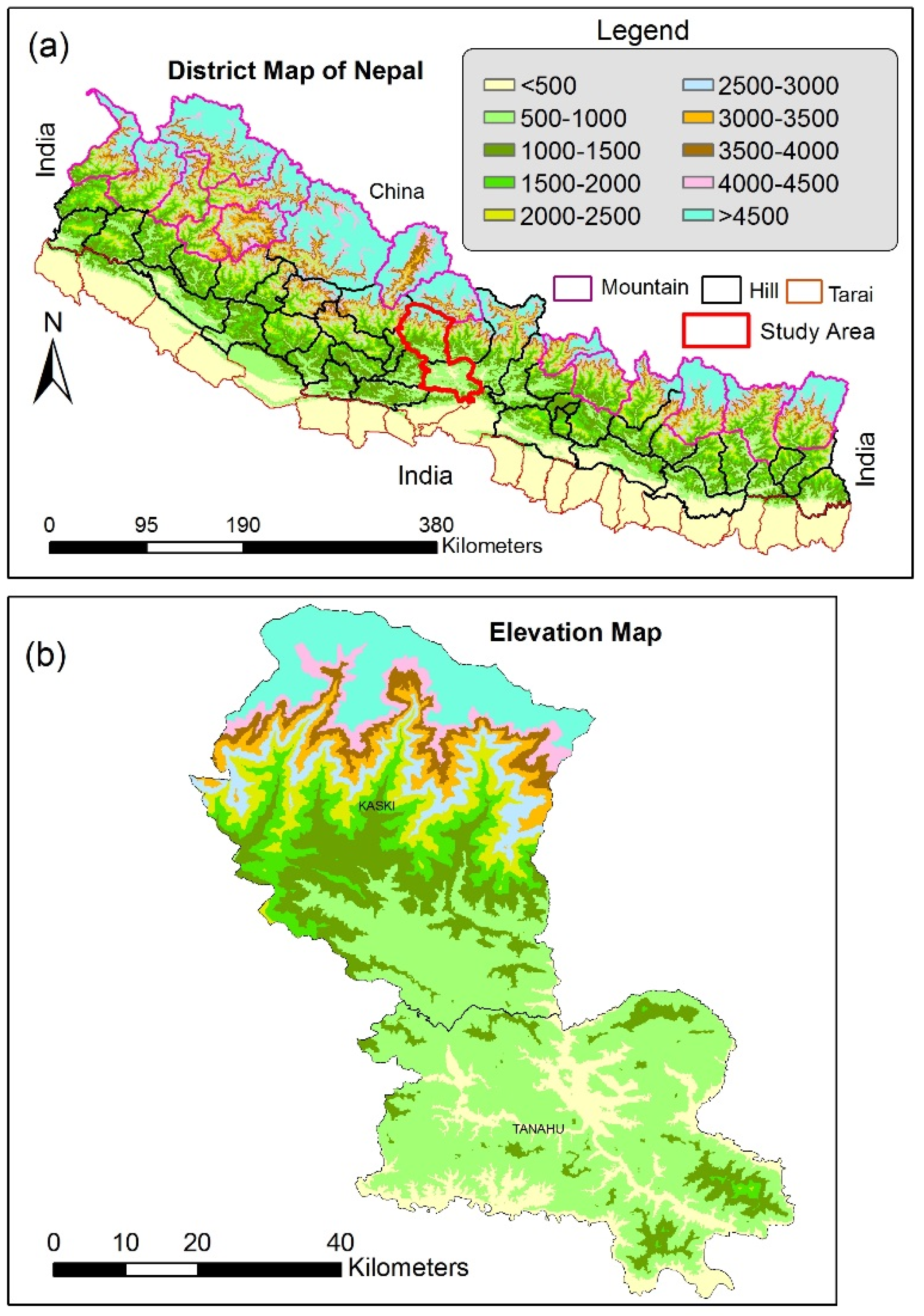
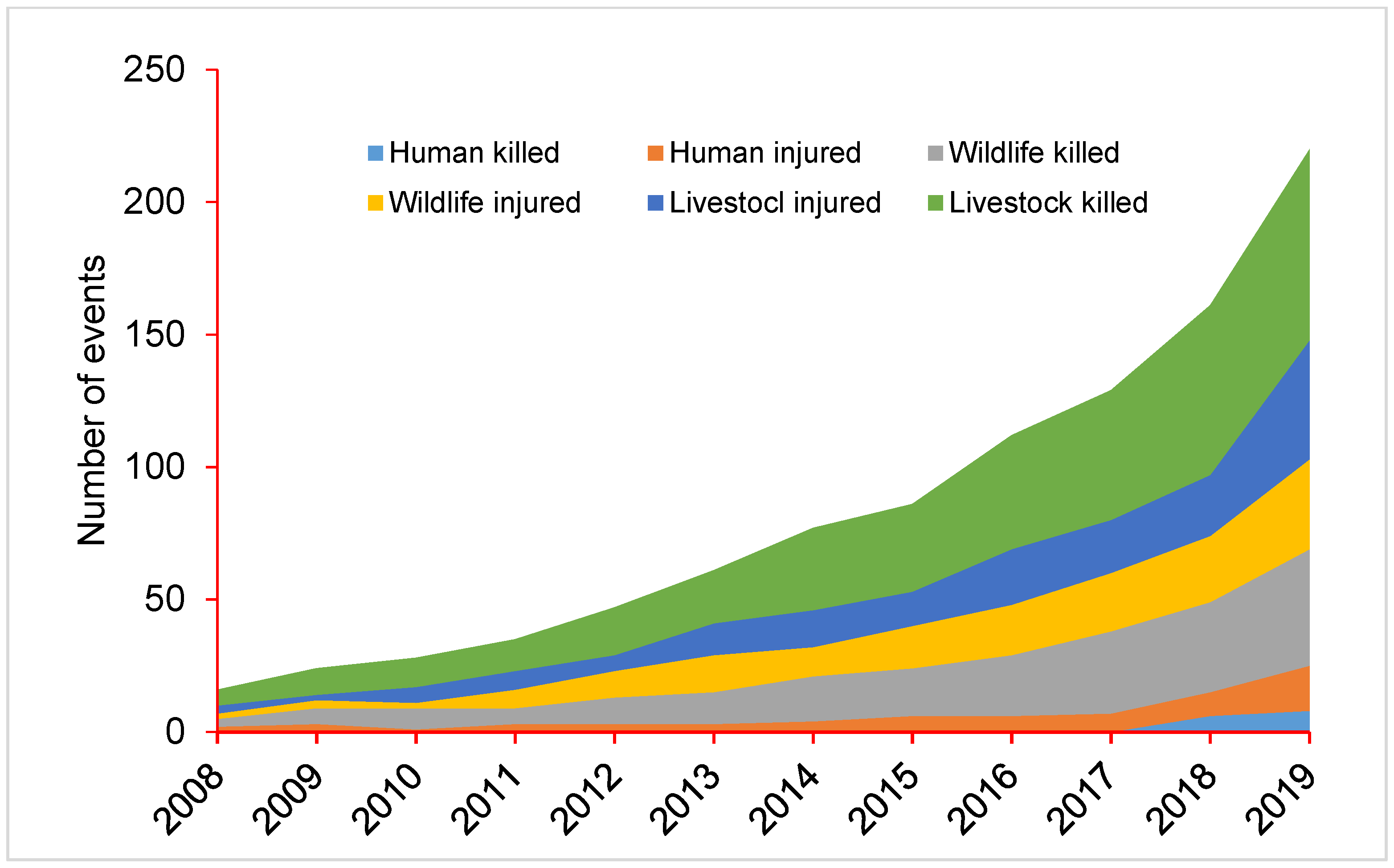
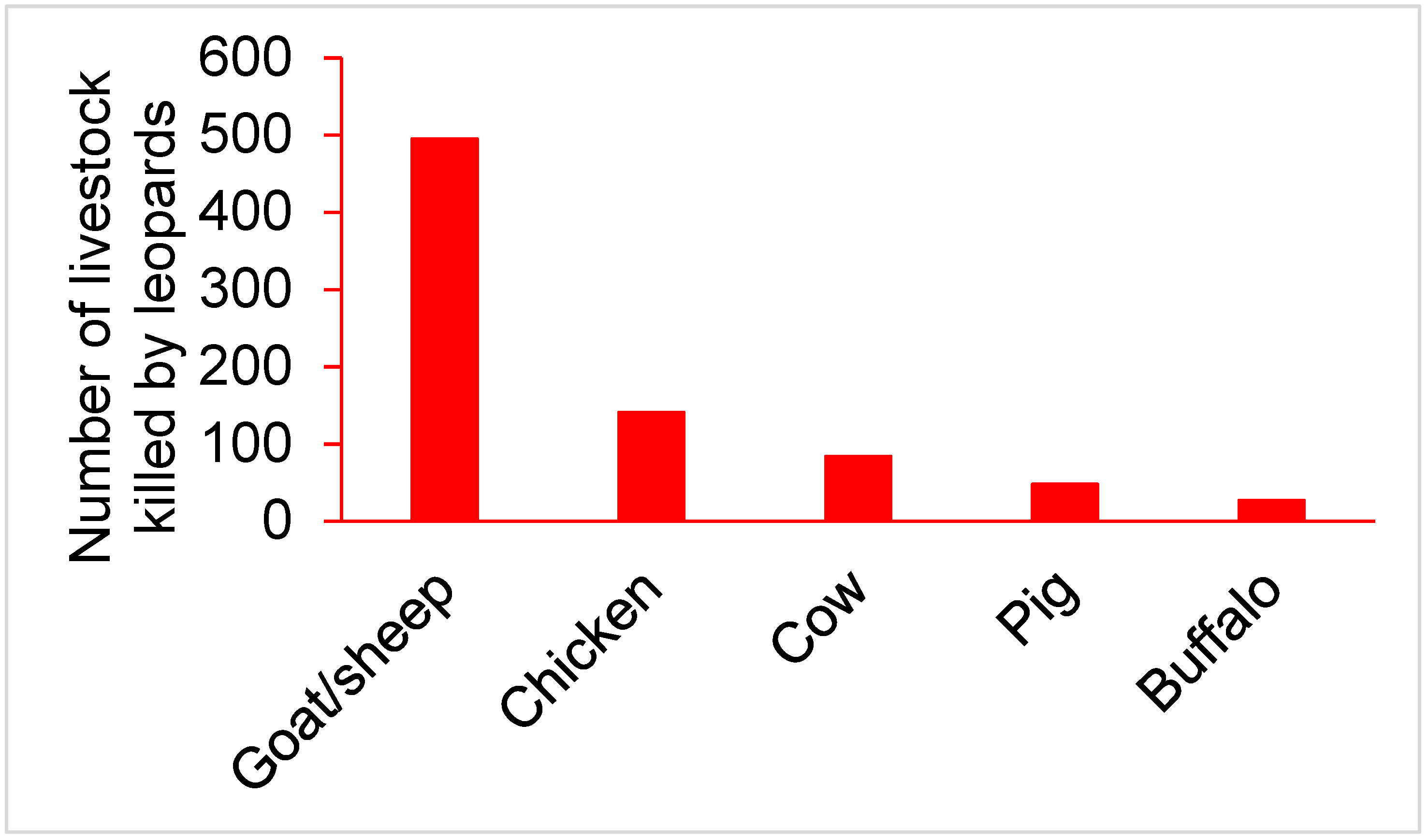
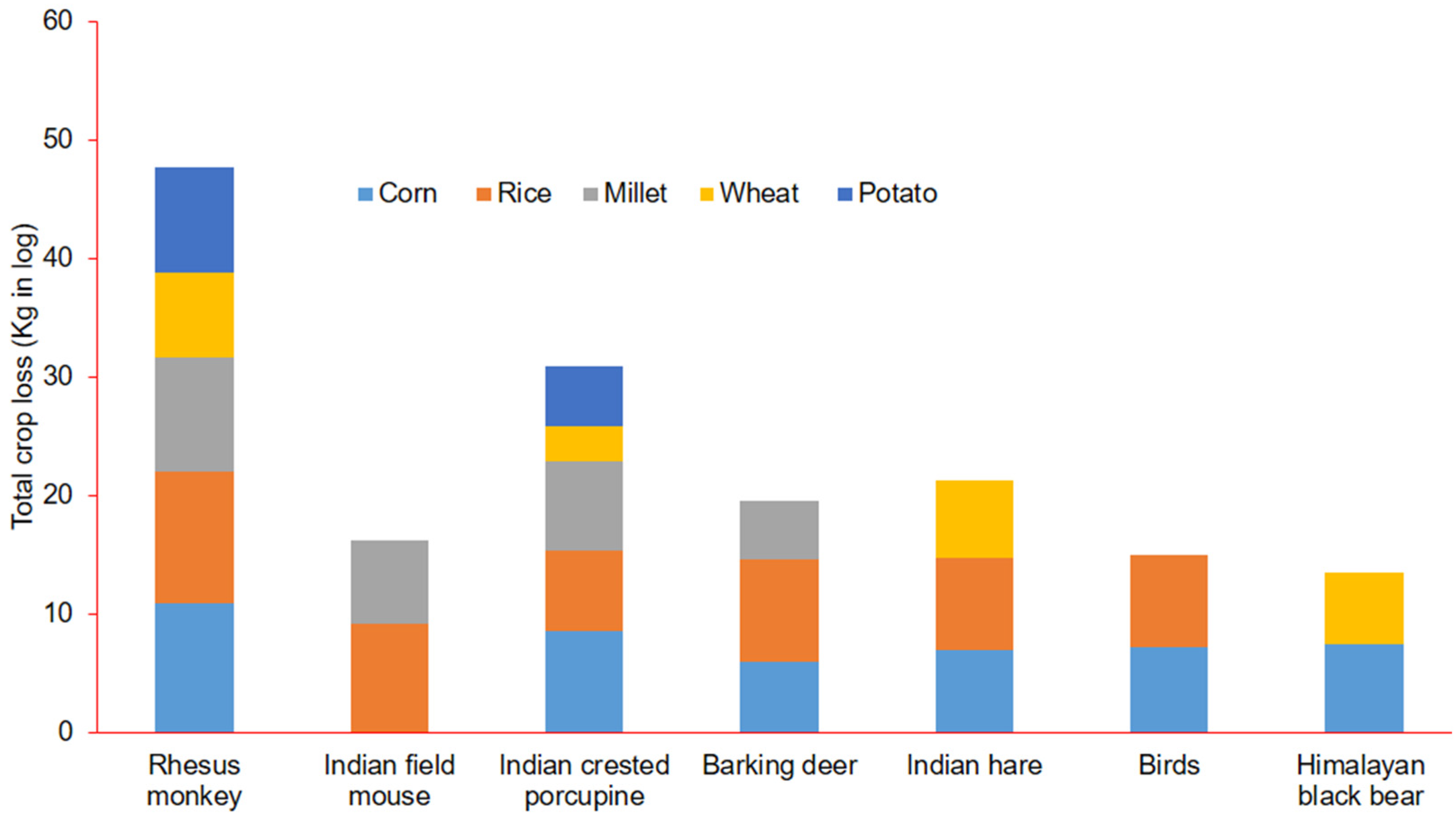
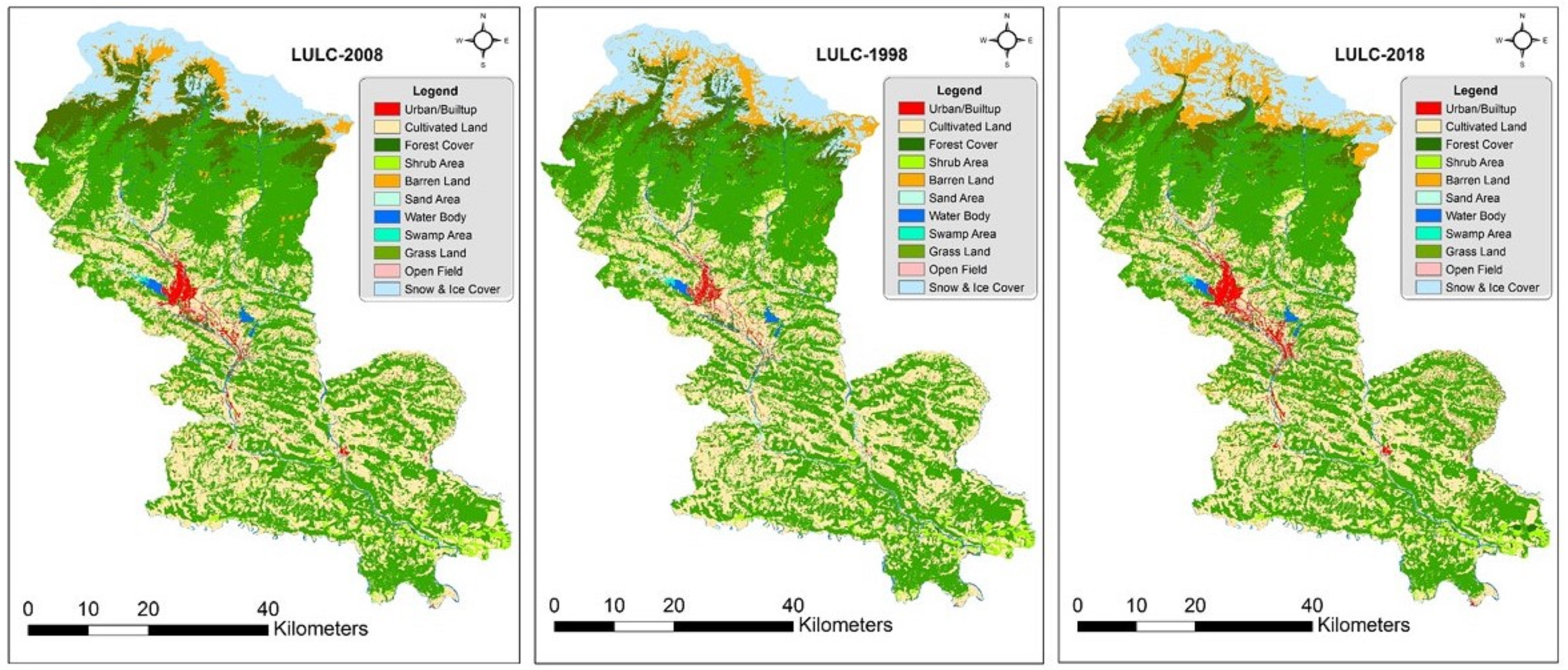
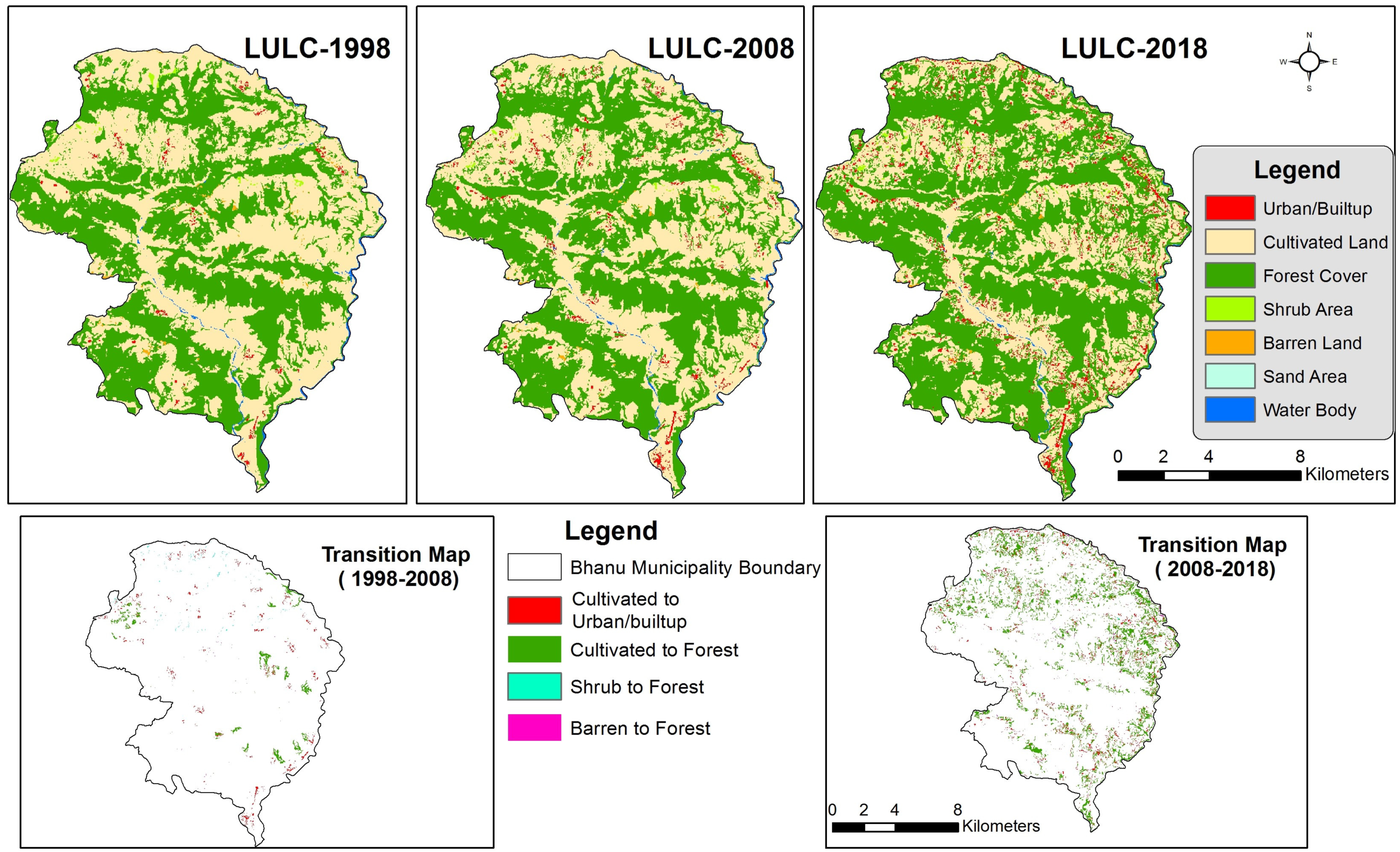
| Demographic information | Gender, Age, Family size |
| Socio economic information | Household income level, Occupation, Literacy level |
| Major crops cultivated | |
| Major livestock reared | |
| HWC related information | |
| A. Crop loss | |
| Year-wise types and amount of crops damaged by wildlife between 2015–2019 | |
| Wild animal involved in these events | |
| Did you see which wild animal was involved in these events? | |
| If you didn’t see, how did you identify which wildlife caused the loss? | |
| What is the current market price of this crop loss? | |
| Distance of crop loss site from nearest village (<1 km, 1–3 km, >3km) | |
| What mitigation measures have you been applying to decrease crop loss by wildlife? | |
| B. Livestock depredation | |
| Year-wise types and number of the livestock injured/killed by wildlife between 2015–2019 | |
| Wild animal involved in these events | |
| Did you see which wild animal was involved in these events? | |
| If you didn’t see, how did you identify which wildlife caused the loss? | |
| What is the current market price of this livestock loss? | |
| Land-use type of event site (settlement, forest, cultivated land/open areas) | |
| What mitigation measures you have been applying to decrease livestock loss by wildlife? | |
| C. Human attack | |
| Year-wise human injury/death caused by wildlife between 2015–2019 | |
| Wild animal involved in these events | |
| Did you see which wild animal was involved in these events? | |
| If you didn’t see, how did you identify which wildlife caused the human attack? | |
| Land-use type of event site (settlement, forest, cultivated land/open areas) | |
| What mitigation measures you have been applying to decrease wildlife attack to humans? | |
| Path/Row | TM-1998 | ETM+1999 | TM-2008 | OLI-2018 |
|---|---|---|---|---|
| 142/040 | 13 December | 26 October | 7 November | |
| 142/041 | 17 February | 13 December | 26 October | 7 November |
Publisher’s Note: MDPI stays neutral with regard to jurisdictional claims in published maps and institutional affiliations. |
© 2021 by the authors. Licensee MDPI, Basel, Switzerland. This article is an open access article distributed under the terms and conditions of the Creative Commons Attribution (CC BY) license (https://creativecommons.org/licenses/by/4.0/).
Share and Cite
Baral, K.; Sharma, H.P.; Kunwar, R.; Morley, C.; Aryal, A.; Rimal, B.; Ji, W. Human Wildlife Conflict and Impacts on Livelihood: A Study in Community Forestry System in Mid-Hills of Nepal. Sustainability 2021, 13, 13170. https://doi.org/10.3390/su132313170
Baral K, Sharma HP, Kunwar R, Morley C, Aryal A, Rimal B, Ji W. Human Wildlife Conflict and Impacts on Livelihood: A Study in Community Forestry System in Mid-Hills of Nepal. Sustainability. 2021; 13(23):13170. https://doi.org/10.3390/su132313170
Chicago/Turabian StyleBaral, Kedar, Hari Prasad Sharma, Ripu Kunwar, Craig Morley, Achyut Aryal, Bhagawat Rimal, and Weihong Ji. 2021. "Human Wildlife Conflict and Impacts on Livelihood: A Study in Community Forestry System in Mid-Hills of Nepal" Sustainability 13, no. 23: 13170. https://doi.org/10.3390/su132313170
APA StyleBaral, K., Sharma, H. P., Kunwar, R., Morley, C., Aryal, A., Rimal, B., & Ji, W. (2021). Human Wildlife Conflict and Impacts on Livelihood: A Study in Community Forestry System in Mid-Hills of Nepal. Sustainability, 13(23), 13170. https://doi.org/10.3390/su132313170






